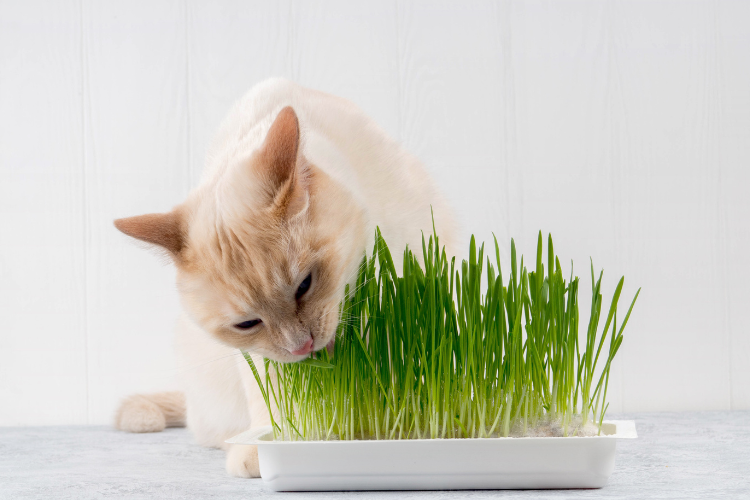There are all sorts of plants that cats like that are perfectly safe for them. While even non-cat owners know about plants like catnip, some lesser-known plants are popular, and even healthy, among cats. Cat grass is a perfect blend of healthy, safe, and easy to grow for your cat.
What is Cat Grass?
Cat grass is a type of grass that is cultivated specifically for cats. Instead of being a single type of plant like catnip, cat grass is actually a blend of seeds, meaning it’s technically more than one type of plant. It belongs to the wider family of grasses but is carefully chosen for its appeal to our feline friends. Often included in pet stores’ shelves, cat grass is a delightful treat for cats that can also serve various health benefits.
Why is it called cat grass?
The term “cat grass” is not merely a marketing strategy; cats seem to enjoy cat grass more than any other creature! Cats are natural hunters and explorers, and offering them a patch of grass taps into their instinctual behaviors. The grass provides a sensory experience for cats, from the texture beneath their paws to the enticing fragrance that wafts through the air.
What makes cat grass different from grass?
Cat grass typically comes from certain cereal grasses, like oats, wheat, barley, or rye. These grasses are chosen for their quick growth and tenderness, making them safe and enjoyable for cats. In contrast to the grasses found in your backyard, cat grass is cultivated without the use of pesticides or other chemicals that might be harmful to your pet.

Is Cat Grass Good for Your Cat?
Yes, cat grass can be beneficial for your feline friend. Cats are obligate carnivores, which means they must eat meat, but they also have a natural instinct to chew on grass. Cat grass provides a safe and satisfying outlet for this behavior. Additionally, the act of chewing on cat grass can help cats eliminate hairballs, providing a natural and enjoyable way to promote digestive health.
Is it OK for cats to eat cat grass every day?
While cat grass is generally safe for cats, moderation is key. Cats may vomit after consuming cat grass, but this is a natural part of the digestive process and is usually not a cause for concern. However, it’s essential to monitor your cat’s consumption and consult with your veterinarian if you have any specific concerns or notice changes in your cat’s behavior.
Is catnip the same as cat grass?
No, catnip and cat grass are distinct plants. Catnip (Nepeta cataria) is a herb that belongs to the mint family, and it contains a compound called nepetalactone that induces a temporary feeling of euphoria in cats. On the other hand, cat grass refers to various cereal grasses that are safe for cats to chew on but do not produce the same behavioral effects as catnip.
What’s the Difference Between Normal Grass and Cat Grass?
To understand the difference between normal grass and cat grass, you need to recognize that “normal” grass is a combination of different types of grasses. Similarly, cat grass is a mixture of grasses that are healthy for cats. Aside from this, the grass growing outside may be exposed to pesticides which, when ingested, can make your cat sick. Cat grass is grown in a controlled environment and is pesticide-free.
What Does Cat Grass Do to Your Cat?
While cat grass won’t give your cat the same warm feelings that catnip does, it can provide some health benefits. Aside from helping with hairballs, cat grass can improve your cat’s digestion and relieve constipation. Like veggies for humans, cat gras also comes packed with nutrients, vitamins, and minerals that are great for your cat’s health.
Cat grass provides mental stimulation for your cat, too. Have you ever noticed your cat trying to chew on houseplants? Biting plants feels good on a cat’s teeth and gives them something to do if bored. So, cat grass can give your cat a fun activity while keeping your plants save. Win win!
How Do You Grow Cat Grass?
Growing cat grass is a simple and rewarding process. You can find cat grass kits in pet stores or purchase seeds online. Plant the seeds in a shallow container filled with potting soil, water regularly, and place it in a sunny location. In about a week, your cat grass should be ready for your feline friend to enjoy.
Does cat grass grow back every year?
Cat grass is an annual plant, meaning it completes its life cycle in one growing season. To ensure a constant supply, you’ll need to replant periodically. Luckily, cat grass grows quickly, and keeping a few containers at different stages of growth can provide a continuous source for your cat’s enjoyment.
- Male vs Female Cats: Exploring the Differences - April 11, 2025
- Why Do Cats Flop When They See You? - March 2, 2025
- What Is Cat Grass? A Healthy Snack for Your Cat - February 22, 2025

